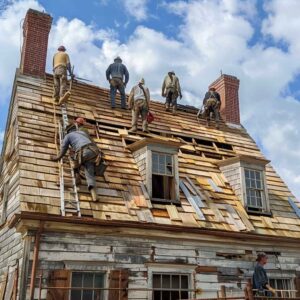You’re in the right place if you’re considering flat roofing for your home or building.
This article will explore the types, advantages, and common materials used in flat roofing. You’ll also learn about the factors to consider before making a decision.
Whether you’re a homeowner or a roofing contractor, this informative guide will help you understand what flat roofing is all about and make an informed choice for your project. Let’s dive in!
Advantages of Flat Roofing
One advantage of flat roofing is its versatility, allowing you to utilize the space for various purposes.
Here are four key advantages of flat roofing:
1. Cost Efficiency: Flat roofs are often more cost-effective than sloped roofs because they require fewer materials and are easier to install. Additionally, flat roofs can be more energy-efficient, reducing heating and cooling costs.
2. Easy Maintenance: Flat roofs have fewer components and a more straightforward structure, making them easier to inspect and maintain. Regular maintenance, such as clearing debris and checking for leaks, can help extend the roof’s lifespan.
3. Extra Space: The flat surface of a flat roof can be used as additional usable space, such as a rooftop garden, outdoor seating area, or even a solar panel installation. This maximizes the potential of the building.
4. Accessibility: Flat roofs provide easier access for maintenance and repairs and for installing HVAC systems and other equipment. This accessibility can save time and money when compared to working on sloped roofs.
Factors to Consider for Flat Roofing
Before making a decision on flat roofing, you should carefully consider certain factors. These factors will help you determine the best option for your specific needs and budget.
Here are four key considerations to keep in mind:
1. Maintenance requirements: Flat roofs require regular maintenance to ensure their longevity. Factors such as debris buildup, ponding water, and membrane damage should be taken into account. Consider the time and resources you are willing to invest in the upkeep of your flat roof.
2. Cost considerations: Flat roofing materials vary in terms of cost. When evaluating the overall cost, factors such as installation, maintenance, and lifespan should be considered. Keep in mind that cheaper materials may have higher maintenance requirements and shorter lifespans, leading to higher long-term costs.
3. Climate and weather conditions: Flat roofs are more susceptible to weather-related issues such as leaks, ponding water, and snow accumulation. Consider your area’s climate and weather patterns to choose a roofing material that can withstand the elements.
4. Building regulations and codes: Ensure the roofing material you choose complies with local building regulations and codes. Failure to do so may result in additional costs and legal issues.
Common Materials for Flat Roofing
To choose the right material for your flat roof, you can start by considering the various options available.
When it comes to flat roofing, there are several common materials that are commonly used.
One popular option is built-up roofing (BUR), which consists of multiple layers of waterproof materials, such as tar, gravel, and felt. BUR is known for its durability and ability to withstand harsh weather conditions.
However, built-up roofing systems require regular inspections and maintenance to prevent leaks and damage.
Another common material is single-ply roofing, which is made of a single layer of synthetic material, such as EPDM or TPO. Single-ply roofing is lightweight, easy to install, and requires minimal maintenance.
There are also options like modified bitumen roofing and metal roofing, each with unique benefits and considerations.
When choosing a material for your flat roof, it is crucial to consider factors such as roofing maintenance and environmental impact to ensure you make an informed decision.





